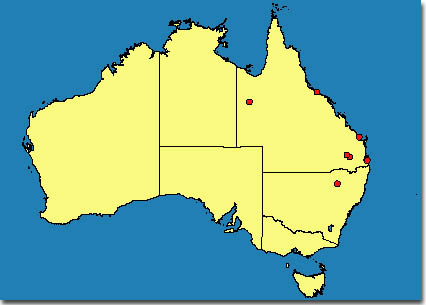

 |
 |
||
|
|
|||
| Diagnosis | Encarsia azimi Hayat |
|||||||||||||
| Species group | ||||||||||||||
| Distribution | ||||||||||||||
| Host | ||||||||||||||
| Comments | ||||||||||||||
| Illustrations | ||||||||||||||
| DNA | ||||||||||||||
Trichaporus indicus Azim & Shafee, 1980: 335. Holotype female, India, Tamil Nadu, Ootacamund, 24.vi.1968 (S.A. Shafee), ex aleyrodid on Nerium (ZDAMU). Preoccupied by P. indica Shafee, 1973: 255. Encarsia azimi Hayat, 1986: 160. Replacement name for indicus Azim & Shafee; Encarsia azimi: Hayat, 1989: 62; Huang & Polaszek, 1998: 1845. Encarsia adrianae Lopez-Avila, 1987: 425. Holotype female, Pakistan, Rawalpindi, iv.1985 ex B. tabaci on Lantana camara [ex culture UK, Ascot, Silwood Park, 26.viii.1986 (A. Lopez-Avila) ex B. tabaci (Gennadius) (BMNH). Synonymy by Hayat, 1998: 202. Encarsia adrianae Lopez-Avila: Polaszek et al., 1992: 381. |
||||||||||||||
Diagnosis |
FemaleColourMesosoma brown and gaster pale yellow to white except with sharply defined dark brown band at base, occasionally gaster more or less darkened. Antenna yellow with pedicel brown and apical segments slightly darkened. MorphologyPedicel longer than F1 (1.17-1.30). F1 distinctly shorter than F2 (0.75-0.88) and F3 (0.63-0.79), respectively. Antennal club 2-segmented. Scutellar sensilla widely separated, approximately 6-7 x the width of a sensillum. Mesoscutal midlobe, axillae, and scutellum with rather fine but distinctive reticulation, cells with distinct internal striations. Distance between anterior pair of scutellar setae larger than that between posterior pair. Fore wing 2.5-2.7 x as long as its maximal width. Marginal fringe 0.30-0.36 x as long as wing width. Apical spur of midtibia shorter than half the length of the basal tarsal segment (0.38-0.44). Ovipositor slightly shorter than or subequal to middle tibia (0.91-1.00). Third valvula 0.36-0.46 x as long as second valvifer. MaleBody brown with mesoscutal midlobe posteriorly and scutellum lighter. Legs brown, tibiae and tarsi light brown. Apical two segments of antenna fused and sensilla partly overlapping. |
|||||||||||||
Species
|
Encarsia inaron-group. | |||||||||||||
Distribution
|
 Click here for material examined window. |
|||||||||||||
Host |
B. tabaci (Gennadius), Lipaleyrodes sp. The following additional hosts have been recorded (Chou et al., 1996, Huang & Polaszek, 1998): Aleurolobus rhododentri Takahashi, Dialeurodes piperis Takahashi, Odontaleyrodes rhododendri (Takahashi), Parabemisia myricae, Rhachisphora fici (Takahashi) (recorded as Dialeurodes citri) |
|||||||||||||
Comments |
Specimens from Narrabri, New South Wales, differ genetically from all other populations of E. azimi: sequence divergence (number of pairwise differences divided by the number of shared nucleotides) of the 28S D2 rRNA gene region between the Narrabri population and other populations is 3.1%, whereas there is no variation among non-Narrabri populations of E. azimi. This degree of genetical difference might indicate the existence of more than one species. However, no consistent morphological differences could be found and the species is currently being studied further. |
|||||||||||||
Illustrations |
|
|||||||||||||
DNA
|
28S-D2 rDNA: GenBank Accession Code: AF254229. |
|||||||||||||
| © Copyright 2001, CSIRO Australia |
| [webmaster - February 2001] |
| Use of this web site and information available from it is subject to our |
| Legal Notice and Disclaimer |